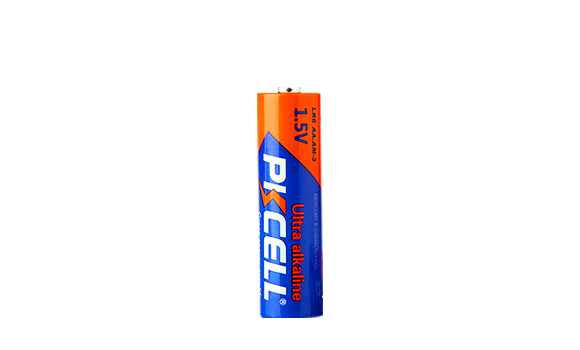Studium przypadku | Urządzenie zabezpieczające
Pkcell zwiększa żywotność baterii Żywotność baterii butelki mleka w proszku przez 50%
LeBaby wykorzystuje ulepszoną baterię Ufine, a produkt nie ma już zacinającego się silnika. Żywotność baterii elektrycznej butelki na mleko w proszku została zwiększona z poprzednich 30 minut do prawie 50 minut.
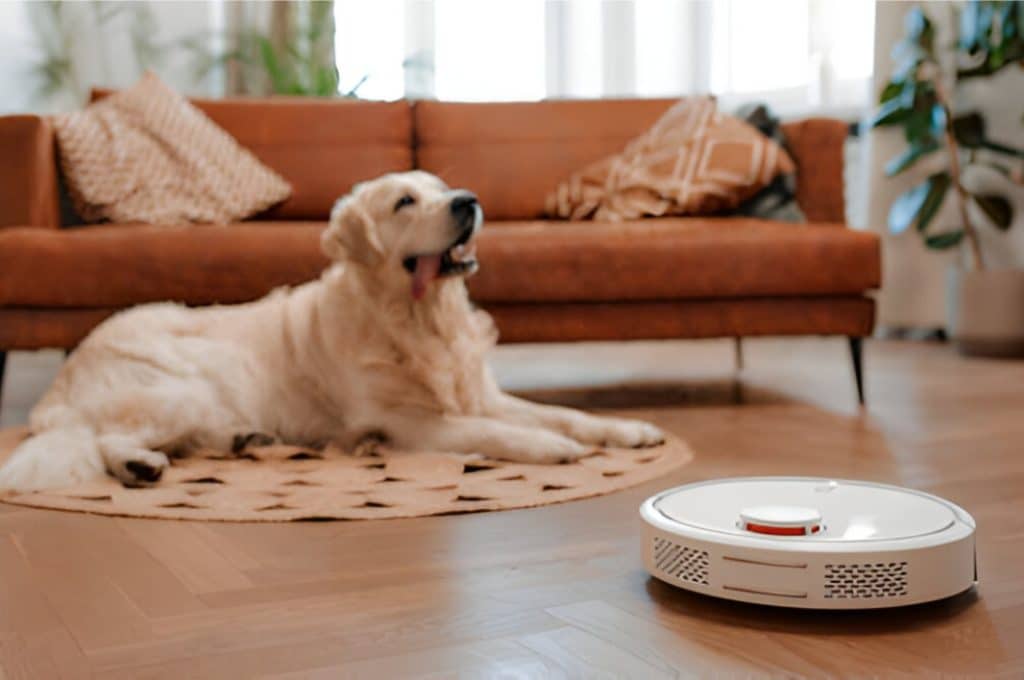
Czym jest LeBaby
LeBaby to marka z Niemiec, której misją jest pomaganie matkom na całym świecie w rodzeniu zdrowych i inteligentnych dzieci. Jest zaangażowana w produkcję serii produktów dla matek, niemowląt i rodziców z dziećmi.
LeBaby jest marką średniej i wysokiej klasy w branży matek i niemowląt. Od momentu powstania, LeBaby dąży do zapewnienia użytkownikom wysokiej jakości produktów i lepszych usług i jest bardzo lubiana przez większość użytkowników. Aby ułatwić większej liczbie osób zakup tego produktu, LeBaby otworzyła również kilka oficjalnych sklepów internetowych i flagowych sklepów w Internecie, aby zapewnić konsumentom większy wybór.

Wyzwanie
Elektryczna butelka na mleko w proszku to nowo opracowany przez firmę LeBaby produkt wspomagający dodawanie i odmierzanie mleka. Ponieważ poprzedni dostawca baterii nie był w stanie zaspokoić potrzeb elektrycznej butelki na mleko w proszku LeBaby pod względem mocy baterii, pojemności i obsługi modułów ładowania bezprzewodowego. Po porównaniu wielu dostawców baterii litowych, firma LeBaby wybrała Ufine jako dostawcę baterii do elektrycznych butelek na mleko w proszku, aby rozwiązać ten problem techniczny.

Silnik zablokowany
Niewystarczające opóźnienie zabezpieczenia płytki drukowanej akumulatora prowadzi do awarii silnika rozruchowego

Silnik zablokowany
Niewystarczające opóźnienie zabezpieczenia płytki drukowanej akumulatora prowadzi do awarii silnika rozruchowego

Silnik zablokowany
Niewystarczające opóźnienie zabezpieczenia płytki drukowanej akumulatora prowadzi do awarii silnika rozruchowego
Znajdź rozwiązanie
Po tym, jak inżynierowie Ufine otrzymali elektryczną butelkę na mleko w proszku LeBaby, która nie działała prawidłowo, przeprowadzili analizę przyczyny problemu i specjalnie dostosowali rozwiązanie baterii litowej odpowiednie dla tego produktu po spotkaniu badawczym z zespołem technicznym.
1. Główną przyczyną zjawiska blokowania się elektrycznej butelki na mleko podczas uruchamiania może być to, że płytka drukowana akumulatora podejmuje działanie ochronne w momencie uruchomienia silnika, powodując, że akumulator nie jest w stanie kontynuować pracy, co powoduje zablokowanie silnika.
Inżynier ds. akumulatorów Ufine użył oscyloskopu do przetestowania akumulatora i uchwycił maksymalny szczytowy prąd roboczy i czas szczytowy. Następnie porównał prąd i czas szczytowy, aby określić parametry obwodu zabezpieczającego akumulator. Po zmodyfikowaniu konfiguracji silnik przestał się zacinać.
2. Głównym powodem niewystarczającej żywotności baterii elektrycznej butelki z mlekiem w proszku jest szybkość rdzenia baterii, to znaczy projekt pojemności rozładowania jest nierozsądny. Gdy elektryczne mleko w proszku działa, ponieważ prąd jest zbyt duży, a konstrukcja akumulatora nie jest wystarczająca, napięcie spada bardziej, powodując, że napięcie jest niższe niż napięcie robocze silnika, a silnik przestanie działać. Jednak w akumulatorze nadal znajduje się więcej niż 20% pojemności, której nie można wykorzystać.
Dlatego też inżynierowie UFine zaprojektowali baterię, która może rozładowywać się w tempie 3C, ale zachowuje tę samą pojemność. Po przeprowadzeniu serii testów, całkowity czas pracy rozładowanej baterii wzrósł o ponad 50%. Dzięki zwiększonemu czasowi pracy akumulatora, jego energia może być lepiej wykorzystana bez zwiększania kosztów.
3. Prędkość ładowania bezprzewodowego jest zbyt niska. Głównym powodem jest zbyt mała szybkość ładowania bezprzewodowego. Ponieważ poprzednie baterie mogły ładować się z prędkością tylko 0,2C, obwód ładowania został zaprojektowany tak, aby ładowanie trwało ponad 5 godzin. Bateria litowa ulepszona przez UFine może być ładowana z prędkością od 1C do 2C. Po wymianie modułu ładowania, bateria może zostać w pełni naładowana w ciągu 1 do 2 godzin.
Powiązany produkt
-
AAA vs AA Battery: Comprehensive Comparison Guide
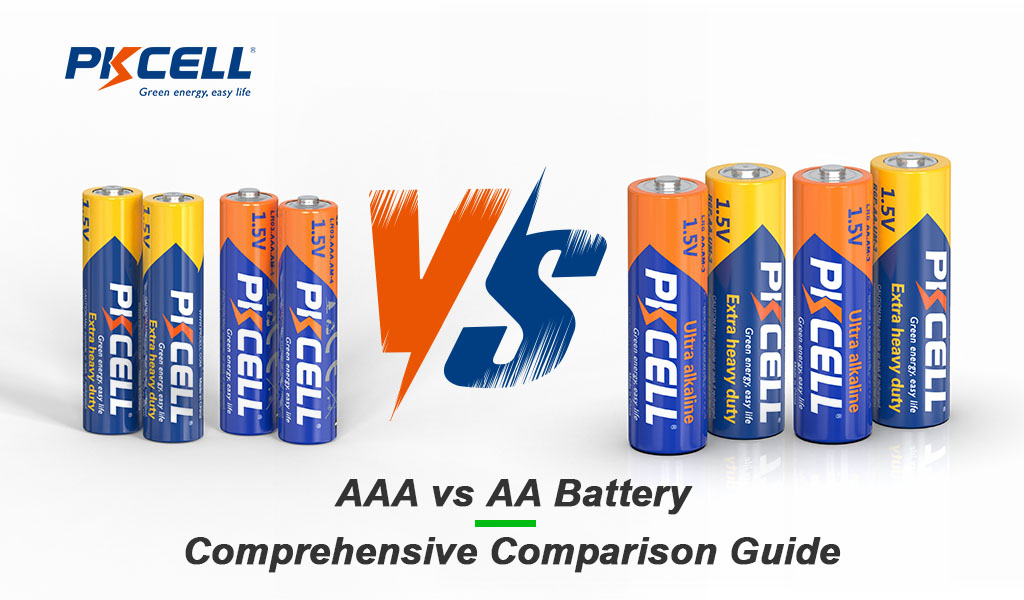
Najważniejsze informacje
- AA and AAA batteries are both cylindrical primary (single use) or secondary (rechargeable) cells, widely used in consumer electronics.
- AA batteries are larger (14.5mm diameter, 50.5mm length) than AAA batteries (10.5mm diameter, 44.5mm length), fitting devices with more space.
- AA batteries typically have higher capacity (1000-3000mAh) compared to AAA batteries (500-1200mAh), supporting longer runtime in medium-power devices.
- Both share similar nominal voltages (1.5V for alkaline, 1.2V for NiMH rechargeables) but differ in power output suitability.
- AA batteries suit devices like remote controls and toys; AAA batteries are ideal for smaller gadgets like TV remotes, wireless mice, and portable flashlights.
Wprowadzenie
AA and AAA batteries are among the most common power sources in household and portable electronics, from remote controls to digital cameras. While they may look similar at first glance, their differences in size, capacity, and performance make them suited for distinct applications. For consumers, product designers, or buyers, understanding these differences is key to choosing the right battery for a device—ensuring optimal performance, avoiding compatibility issues, and balancing cost and efficiency. This guide breaks down the core distinctions between AA and AAA batteries to help you make informed decisions.
Understanding AA and AAA Batteries
Both AA and AAA batteries are cylindrical, standardized cells used to power low-to-medium energy devices. They are available in two main types: single-use alkaline (disposable) and rechargeable NiMH (nickel-metal hydride). Their names (AA, AAA) derive from size standards set by industry bodies, with “AAA” indicating a smaller form factor than “AA.” Choosing the wrong size can lead to poor fit, reduced device performance, or even damage—for example, a loose AAA battery in an AA-sized compartment may rattle, causing intermittent power loss. While their chemical compositions (alkaline or NiMH) are often similar, their physical and performance traits diverge significantly.
The Basics of AA Batteries
AA batteries are the larger of the two, with a standard diameter of 14.5mm and length of 50.5mm. They are versatile, available in both alkaline (single use) and NiMH (rechargeable) variants.
Alkaline AA batteries typically have a nominal voltage of 1.5V, while rechargeable NiMH AA batteries operate at 1.2V. Their capacity ranges widely: alkaline AA batteries usually offer 1000-2700mAh, while high-quality NiMH versions can reach 2000-3000mAh. This higher capacity makes them ideal for devices that draw moderate power over extended periods, such as toys, portable radios, electric shavers, and digital cameras.
Click Here to quote for AA Alkaline batteries
Click Here to quote for AA Ni-MH batteries
The Basics of AAA Batteries
AAA batteries are smaller, with a diameter of 10.5mm and length of 44.5mm, about 30% smaller than AA batteries. Like AA batteries, they come in alkaline (1.5V) and NiMH (1.2V) options.
Their capacity is lower due to their smaller size: alkaline AAA batteries typically range from 500-1000mAh, while rechargeable NiMH AAA batteries offer 600-1200mAh. This makes them better suited for low-power, compact devices where space is limited, such as TV remotes, wireless computer mice, small flashlights, and portable gaming controllers.
Click Here to quote for AAA Alkaline batteries
Click Here to quote for AAA Ni-MH batteries
Key Differences Between AA and AAA Batteries
The primary differences lie in size, capacity, and suitability for specific devices—traits that directly impact how they perform in real-world use.
Wymiary fizyczne i kompatybilność
Size is the most obvious distinction. AA batteries’ larger dimensions (14.5mm x 50.5mm) require more space in device compartments, while AAA batteries (10.5mm x 44.5mm) fit into slimmer, more compact designs.
Device manufacturers design battery compartments to match specific sizes, so an AAA battery cannot reliably replace an AA battery (it will be too small, leading to loose connections), and vice versa (an AA battery will not fit into an AAA compartment). Always check the device manual for size requirements.
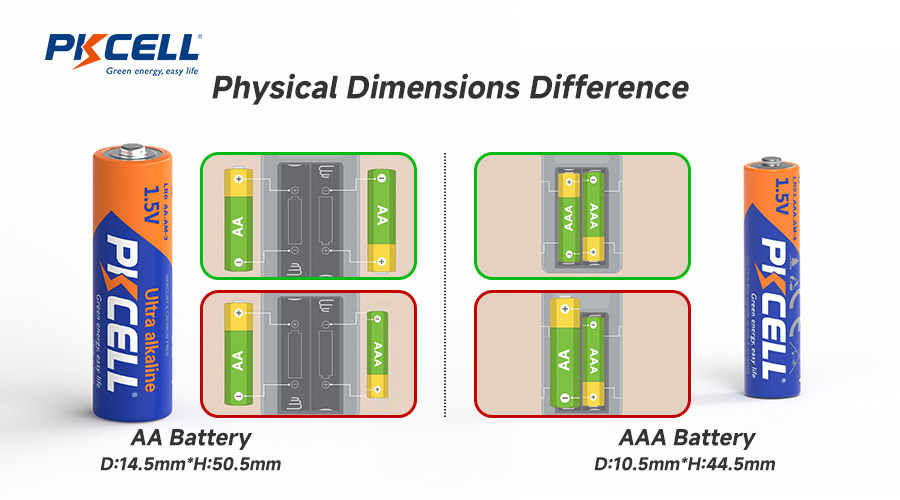
Wydajność i produkcja energii
AA batteries’ larger volume allows them to store more energy. For example, a high-capacity alkaline AA battery (2700mAh) can power a toy car for 4-6 hours, while an AAA battery (1000mAh) in the same device would last 1-2 hours.
Discharge rates (how quickly energy is released) are similar for both when chemistry is the same (e.g., alkaline or NiMH), but AA batteries’ higher capacity means they sustain power longer in devices with steady energy demands (like a portable fan), whereas AAA batteries excel in devices with brief, low power uses (like a remote control button press).
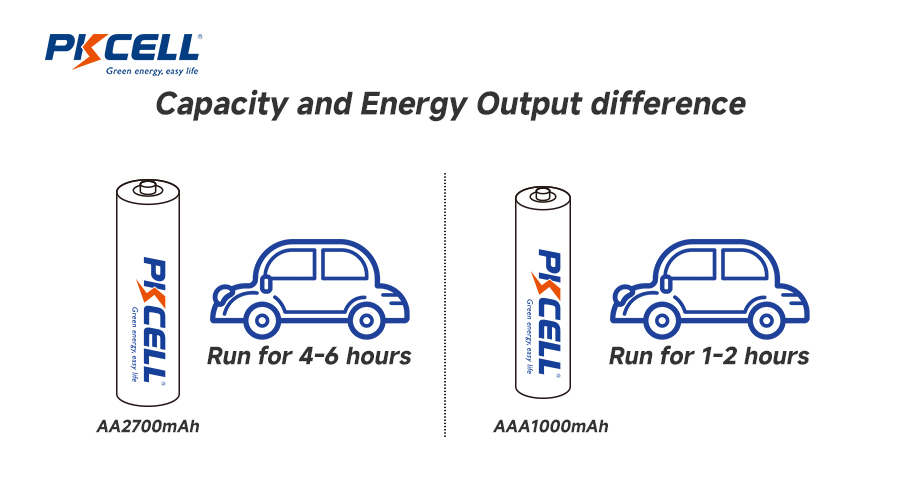
Comparison Table: AA vs AAA Battery
Cecha Bateria AA AAA Battery Średnica 14.5mm 10.5mm Długość 50.5mm 44.5mm Napięcie nominalne 1.5V (alkaline); 1.2V (NiMH) 1.5V (alkaline); 1.2V (NiMH) Zakres wydajności 1000-3000mAh 500-1200mAh Typowa szybkość rozładowania Moderate to high Low to moderate Typowe zastosowania Toys, cameras, shavers Remotes, mice, small flashlights Zalety i wady każdego typu baterii
Pros and Cons of AA Batteries
– Pros: Higher capacity for longer runtime; versatile for medium-power devices; widely available; rechargeable versions offer cost savings over time.
– Cons: Larger size limits are used in compact devices; alkaline variants generate more waste when disposed of; heavier than AAA batteries.
Pros and Cons of AAA Batteries
– Pros: Compact size fits small devices; lightweight; sufficient for low-power needs; affordable and easy to find.
– Cons: Lower capacity leads to shorter runtime; not suitable for high-power devices; rechargeable versions may have shorter lifespans than AA NiMH.
Wnioski
AA and AAA batteries are foundational to everyday electronics, but their differences in size and capacity make them far from interchangeable. AA batteries excel in medium-power, space-available devices, offering longer runtime, while AAA batteries are the go-to for small, low-power gadgets. When choosing, consider your device’s size, power demands, and whether rechargeable (for frequent use) or disposable (for occasional use) options make more sense.
Why Choose Pkcell as Your AAA and AA Batteries Supplier?
PKCELL is a leading B2B battery supplier with over 20 years of experience, offering high-quality AAA and AA batteries for a wide range of industrial and commercial applications. Our AA and AAA batteries, available in both alkaline and rechargeable NiMH versions, deliver reliable, long-lasting performance for everyday and professional devices. With advanced manufacturing, strict quality control, and certifications like ISO9001, CE, and RoHS, PKCELL ensures consistent product quality and dependable supply.
Reach out to us today for custom solutions and bulk pricing.
Często zadawane pytania
Can I use AA batteries in a device designed for AAA?
No. AA batteries are larger than AAA batteries and will not fit into AAA compartments, potentially damaging the device or causing safety risks. Always use the size specified by the manufacturer.
Are rechargeable AA and AAA batteries worth it?
Yes, if the device is used frequently. Rechargeable NiMH AA/AAA batteries can be reused 500-1000 times, reducing long-term costs compared to disposable alkaline batteries. They are ideal for high-use devices like toys or cameras.
Do AA and AAA batteries have the same lifespan?
Alkaline AA batteries generally last longer in storage (5-10 years) than alkaline AAA batteries (3-7 years) due to their larger capacity. Rechargeable NiMH batteries have similar shelf lives (3-5 years when stored properly) but self-discharge more
Dowiedz się więcej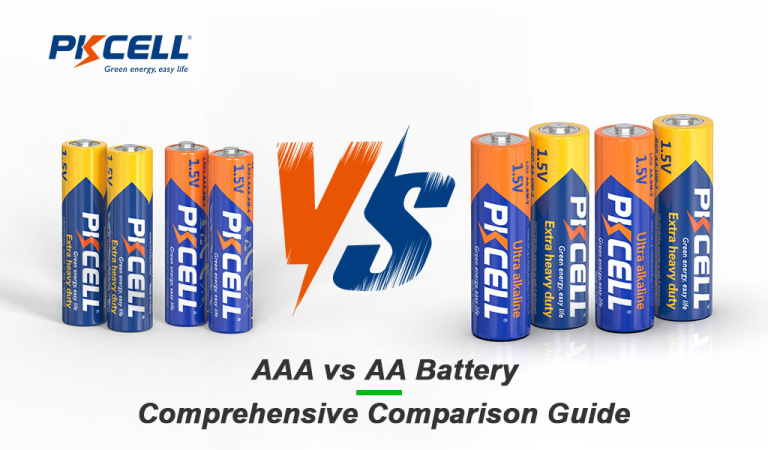
-
Akumulator litowy USB-C 1,5 V D 7400 mWh
- Maksymalny stały prąd ładowania: 500 mA
- Maksymalny ciągły prąd rozładowania: 2000 mA
- Żywotność: 300+
- Temperatura pracy: -20~60 °C
Dowiedz się więcej
-
Akumulator litowy USB-C 1,5 V C 5000 mWh
- Maksymalny stały prąd ładowania: 500 mA
- Maksymalny ciągły prąd rozładowania: 2000 mA
- Żywotność: 300+
- Temperatura pracy: -20~60 °C
Dowiedz się więcej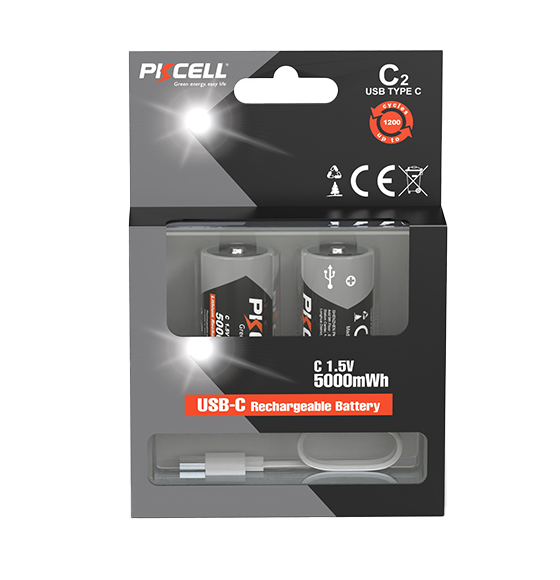
Masz wyzwanie?
Znajdźmy ekskluzywne rozwiązanie akumulatorowe!
Skontaktuj się z nami
-
 Telefon86-755-86670609
Telefon86-755-86670609 -
 E-mail
E-mail -
 Adres firmy9. piętro, blok B, Hongrongyuan North Station Center, nr 328, Mintang Road, Longhua District, Shenzhen, Chiny, 518110
Adres firmy9. piętro, blok B, Hongrongyuan North Station Center, nr 328, Mintang Road, Longhua District, Shenzhen, Chiny, 518110

 Bateria litowa ładowana przez USB
Bateria litowa ładowana przez USB
